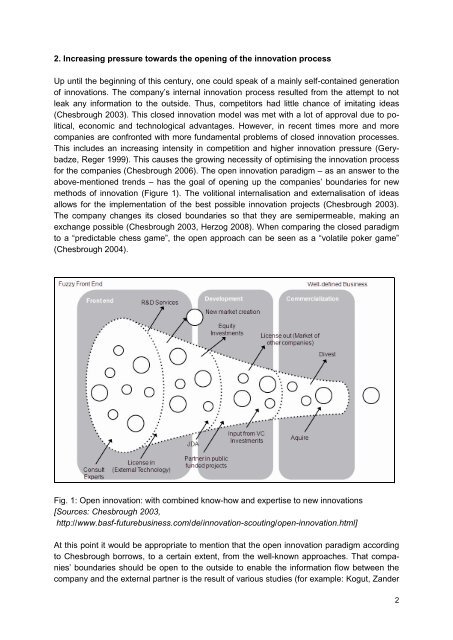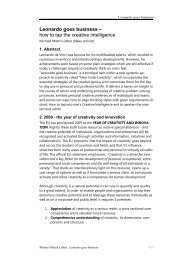Keynote speech - M.Sc. in Strategic Innovation & Future Creation
Keynote speech - M.Sc. in Strategic Innovation & Future Creation
Keynote speech - M.Sc. in Strategic Innovation & Future Creation
Create successful ePaper yourself
Turn your PDF publications into a flip-book with our unique Google optimized e-Paper software.
2. Increas<strong>in</strong>g pressure towards the open<strong>in</strong>g of the <strong>in</strong>novation process<br />
Up until the beg<strong>in</strong>n<strong>in</strong>g of this century, one could speak of a ma<strong>in</strong>ly self-conta<strong>in</strong>ed generation<br />
of <strong>in</strong>novations. The company’s <strong>in</strong>ternal <strong>in</strong>novation process resulted from the attempt to not<br />
leak any <strong>in</strong>formation to the outside. Thus, competitors had little chance of imitat<strong>in</strong>g ideas<br />
(Chesbrough 2003). This closed <strong>in</strong>novation model was met with a lot of approval due to political,<br />
economic and technological advantages. However, <strong>in</strong> recent times more and more<br />
companies are confronted with more fundamental problems of closed <strong>in</strong>novation processes.<br />
This <strong>in</strong>cludes an <strong>in</strong>creas<strong>in</strong>g <strong>in</strong>tensity <strong>in</strong> competition and higher <strong>in</strong>novation pressure (Gerybadze,<br />
Reger 1999). This causes the grow<strong>in</strong>g necessity of optimis<strong>in</strong>g the <strong>in</strong>novation process<br />
for the companies (Chesbrough 2006). The open <strong>in</strong>novation paradigm – as an answer to the<br />
above-mentioned trends – has the goal of open<strong>in</strong>g up the companies’ boundaries for new<br />
methods of <strong>in</strong>novation (Figure 1). The volitional <strong>in</strong>ternalisation and externalisation of ideas<br />
allows for the implementation of the best possible <strong>in</strong>novation projects (Chesbrough 2003).<br />
The company changes its closed boundaries so that they are semipermeable, mak<strong>in</strong>g an<br />
exchange possible (Chesbrough 2003, Herzog 2008). When compar<strong>in</strong>g the closed paradigm<br />
to a “predictable chess game”, the open approach can be seen as a “volatile poker game”<br />
(Chesbrough 2004).<br />
Fig. 1: Open <strong>in</strong>novation: with comb<strong>in</strong>ed know-how and expertise to new <strong>in</strong>novations<br />
[Sources: Chesbrough 2003,<br />
http://www.basf-futurebus<strong>in</strong>ess.com/de/<strong>in</strong>novation-scout<strong>in</strong>g/open-<strong>in</strong>novation.html]<br />
At this po<strong>in</strong>t it would be appropriate to mention that the open <strong>in</strong>novation paradigm accord<strong>in</strong>g<br />
to Chesbrough borrows, to a certa<strong>in</strong> extent, from the well-known approaches. That companies’<br />
boundaries should be open to the outside to enable the <strong>in</strong>formation flow between the<br />
company and the external partner is the result of various studies (for example: Kogut, Zander<br />
2



